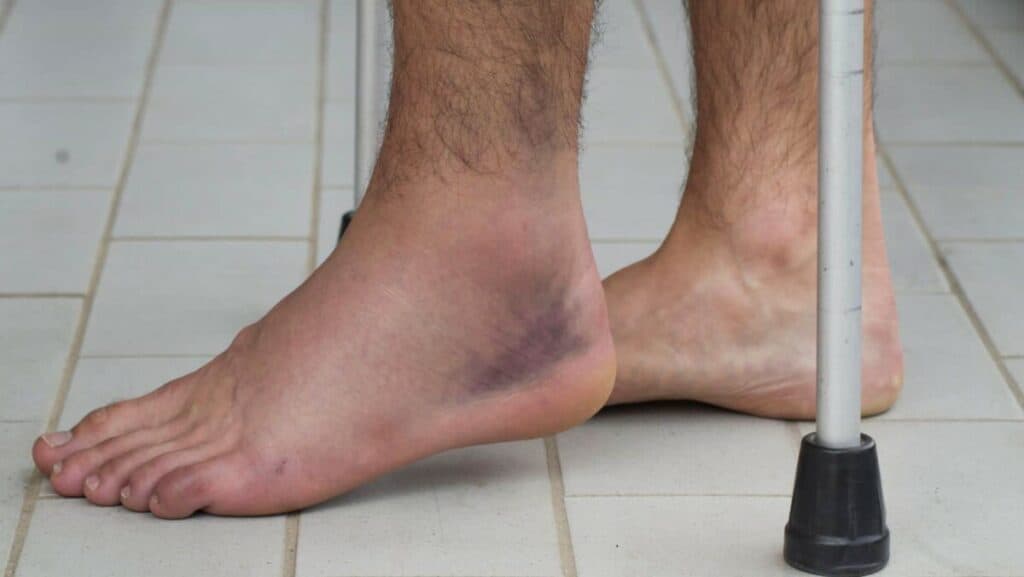Sprained Ankle vs Broken Ankle
- Best Asics Shoes for Flat Feet - October 25, 2024
- Best Running Shoes for Flat Feet - October 22, 2024
- Posterior Tibial Tendonitis - October 21, 2024
Key differences between a Sprained Ankle and a Broken Ankle
A sprained ankle is the tear of one or more of the ligaments that support the ankle, while a broken ankle is a fracture of one or more of the three bones of the ankle joint.
A broken ankle requires immediate immobilisation in a walker boot or cast, while a sprained ankle begins physical rehabilitation immediately.
A broken ankle can be detected on an X-ray or an MRI, while a sprained ankle requires an ultrasound or MRI to establish a diagnosis.
Anatomy is essential for differentiating between the two; 3 bones comprise the ankle: the Talus, Fibula and Tibia. There are ligaments surrounding the ankle to support it, such as the lateral ligaments on the outside of the ankle, strong ligaments at the front and deltoid ligaments on the inner aspect of the ankle.
This article will explore the finer differences between a sprained and broken ankle.
Symptoms
Symptoms of a sprained ankle include a sudden onset of pain after a twisting or turning motion.
The location of the pain is over the injured soft tissue, and it is common for there to be swelling almost immediately around the affected ligament.
A broken ankle bone has an immediate onset of pain and swelling that can be associated with an audible click or popping noise.
It is usually too painful to bear weight or walk on a broken ankle, and in the acute stages, patients often report a numb sensation that is not present with a sprain.
In severe cases of an ankle dislocation, the patient experiences a broken bone and complete tears to the ankle ligaments. In these cases, the foot usually is pointing in an abnormal direction.

Causes
A sprained ankle occurs most commonly in the lateral ligaments of the ankle; a sudden twist causes a sprain of these ligaments, whereas a broken ankle is often the result of direct trauma to the ankle joint from a tackle or a fall.
Stress fractures of the ankle can occur innocuously, especially in people with Osteoporosis. In contrast, a sprained ankle typically has a definitive mechanism of injury, such as walking on uneven pavement.
A sprained ankle is more common in change-of-direction sports as high-stress levels are placed on the ligaments, while a fall is more likely to cause a broken ankle.

Diagnosis
Sprained Ankle
A physical evaluation, including special clinical tests such as an anterior drawer or talar tilt tests, is sufficient to diagnose a sprained ankle. It is important to rule out any fractures, and most clinicians apply the OTTOWA rules during their assessment.
Some cases may require a scan to identify the severity of a sprained ankle; an MRI is the gold standard form of imaging, but often, an ultrasound is sufficient and more cost-effective.
Broken Ankle
A Physical therapist can evaluate an injured ankle for a fracture based on a patient’s symptoms: pain on hopping and pain on palpation of the affected bone. If these factors are present alongside an inability to weight-bear, then there is a significant likelihood that the patient has encountered an ankle fracture.
Still, a broken ankle requires an X-ray to confirm the diagnosis. We know that the sensitivity is low for X-rays, so if the results return as normal, clinically, we suspect it is a fracture. Then, we might refer to an MRI for better detail.
Treatment
Sprained Ankle
A comprehensive rehabilitation protocol can begin immediately post-injury. Sprained ankle rehabilitation consists of strengthening, stretching and balance exercises that should become increasingly difficult over 4-8 weeks.
Exercises may begin as resistance band exercises followed by weight-bearing strengthening of the plantar flexor muscles. This progresses to balance, jumping, and multi-directional hopping before returning to running.
Broken Ankle
In contrast, a stable broken ankle requires 4-6 weeks in a walker boot to allow the bone to unite before transitioning into a normal walking shoe. Rehabilitation is similar to a sprained ankle; however, more muscle atrophy is usually associated with a broken ankle from the time spent in the boot.
Trying some early-stage, non-weight-bearing resistance band work once daily is common to reduce the risk of muscle atrophy.
It is important to address the cause of injury during the rehabilitation process and adjects to recovery such as an ankle brace or supportive footwear should be considered.
______________________________________________________________
We specialise in treating foot conditions and have experts in foot specialists in our Fulham, South West London clinic. We also run a specialist Biomechanics and Custom Orthotics Service.
Related Articles:
Causes of Inner Ankle Pain – Footwear after 5th Met Fracture – Best Exercises for Flat Feet
